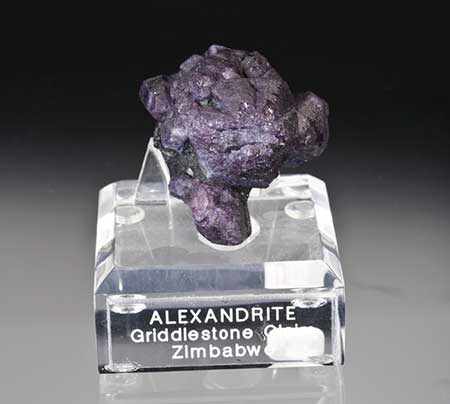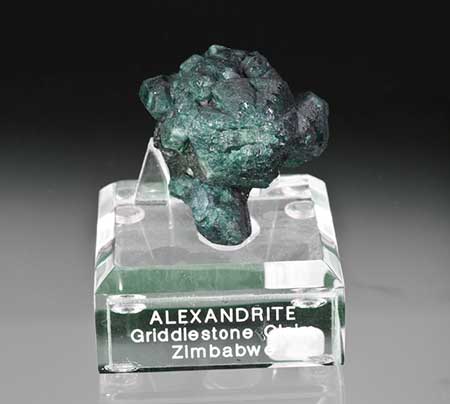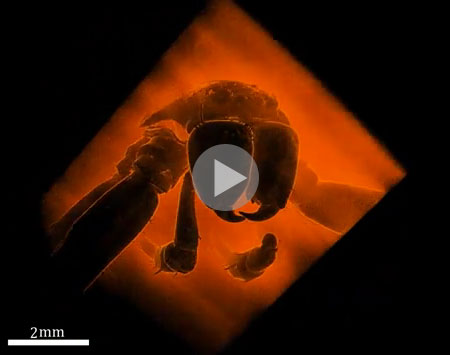
2015.2 | 2015.1 | 2014.2 | 2014.1
2013.2 | 2013.1 | 2012.2 | 2012.1 | 2011.2 | 2011.1 | 2010.2 | 2010.1
2009.2 | 2009.1 | 2008.2 | 2008.1 | 2007.2 | 2007.1 | 2006
August – December 2011
- December 2011 News Flash – December 29
- December 2011 Newsletter – December 2
- October 2011 Newsletter – October 5
- September News – September 2
- August 2011 Newsletter – August 2
December 2011 News Flash
Breaking News from Santa Barbara Museum of Natural History
Theft of Stones on Loan
December 29 — We just received word of a theft two nights ago at the Santa Barbara Museum of Natural History. The theft consisted of stones on loan to the museum from the Natural History Museum of Los Angeles County, including the benitoite pictured below.
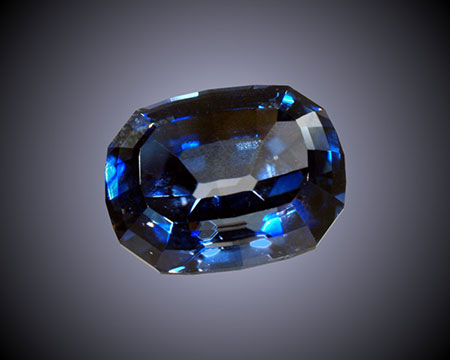 |
| Stolen. This 2.9-carat benitoite, 9 x 7 x 5 mm, was stolen two nights ago. |
The Santa Barbara Museum of Natural History can be contacted at 805.682.4711.
— End December News Flash • Published 12/29/11 —
December 2011 Newsletter
As this edition of Pala Mineralis goes to e-press with the first installment of Kyaw Thu’s study of the Mogok Stone Tract, we are compelled to note this week’s historic visit to Burma by Secretary of State Hillary Clinton. The only other secretary of state to do so was John Foster Dulles in 1955.
Shows and Exhibitions
- Tucson Time: January 31 – February 12, 2012
- Sainte-Marie Scission: Early move to Colmar
- Missive from Munich: A report by Will Larson
Pala International News
Mineral and Mineralogy News
Industry News
Pala Presents
- The Igneous Rocks of the Mogok Stone Tract
A PhD Dissertation by Kyaw Thu
Recycle Bin
Shows and Exhibitions
Tucson Time: January 31 – February 12, 2012
After the holidays, we’re looking forward to the world’s greatest gem and mineral show in February. One-stop general information about individual shows can be obtained from the Tucson EZ-Guide.
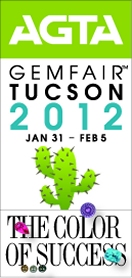 |
Pala International will be represented in Tucson as follows. We look forward to seeing our many friends there. Visit the Pala International Show Schedule for future events.
AGTA GemFair
Pala joins nearly 100 exhibitors for this annual extravaganza.
Event: AGTA GemFair
When: January 31 – February 5, 2012
Where: Tucson Convention Center
Booth: 1016
The event website now features an interactive floorplan allowing you to see who is exhibiting by area of the convention center.
More than forty free seminars are offered by notables in the world of gemstones and pearls.
11th Annual Westward Look Mineral Show
Pala International and two dozen other world-class mineral dealers shack up at a Sonoran Desert resort.
 |
- Collector Day (Sat) features Ron Gladnick and selections from his private collection
- Edward Swoboda: “A Life of Gems & Minerals” (Sun) is a rare opportunity to take in a presentation by this 94-year-old legend of the mineral collecting world. Also on hand will be special guests Wendell Wilson, Bill Larson and Gene Meieran
Event: 11th Annual Westward Look Mineral Show
When: February 3–6, 2012
Where: Westward Look Resort
Suite: 224
See Pala International’s page on the Westward Look Show site.
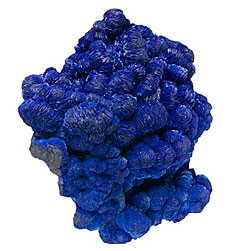 |
| Blue blade. This azurite is an old piece from the Clifton Mine in Clifton, Arizona. It’s available at Inventory #17844. (Photo: John McLean) |
58th Annual Tucson Gem and Mineral Show
TGMS is the largest gem and mineral show in the country. This year’s theme is “Minerals of Arizona.”
Event: 58th Annual Tucson Gem and Mineral Show
When: February 9–12, 2012
Where: Tucson Convention Center
Booth: Aisle 5 East
A list of speakers was not available at e-press time. [back to top]
Tucson Transit Tips
Many shows will offer their own shuttles. View your transit and parking options here. [back to top]
Sainte-Marie Scission
Early move to Colmar for Euro-Mineral & Euro-Gem
A planned 2014 move of Euro-Mineral & Euro-Gem from Sainte-Marie-aux-Mines to nearby Colmar will take place two years early due to a breakdown in negotiations, according to a statement by Michel Schwab, who has directed the show for thirty years. In 2010, two studies convinced Schwab and some other organizers that the move was needed; now it’s taking place ahead of schedule.
Colmar is the capital of the Haut-Rhin department in which Sainte-Marie is situated, and the city lies on the eastern edge of the Parc naturel régional des Ballons des Vosges (named for the round, balloon-like mountains) that is home to Sainte-Marie. Colmar, with an urban-area population in 2008 of 126,000, is nearly 17 times larger than tiny Sainte-Marie. The show is taking advantage of the city’s Parc des Expositions de Colmar, with five halls totaling nearly 14,000 square meters (500,000 sq. ft.) of space.
On November 10, Sainte-Marie mayor Claude Abel and manager (and former Euro-Gem organizer) Raymonde Kistler announced that the town would host its own, competing event, which will take place the same days as the Colmar show, June 21–24, 2012. The “new” group, which stems from Sainte-Marie’s town council, goes by the name of Mineral & Gem à Sainte-Marie-aux-Mines. The organization’s website expects to have pages in English on December 4. A letter of explanation to prospective exhibitors was issued yesterday in English.
Fortunately the two venues are 35 km apart. Pala International plans to attend both next June.
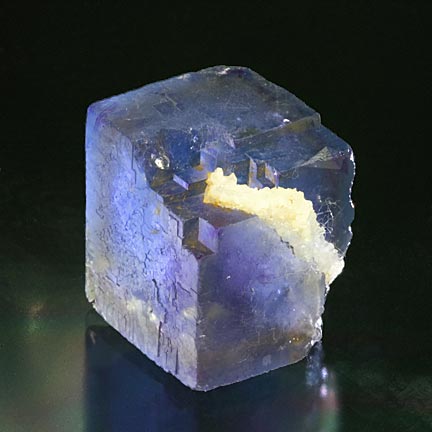 |
| Bon choix. This fluorite from Puy-de-Dôme in central France’s Auvergne region, is perhaps as conflicted as dealers will be in choosing where to show in June. The specimen’s surface of smoke is tinged with color, reluctantly revealing a blue interior cube. See Inventory #19418 for two more views. (Photo: John McLean) |
[back to top]
Missive from Munich
Pala’s Will Larson reports on a successful show
Pala’s first exhibition at The Munich Show in more than a decade was successful. We were in full force partnered with French dealers Christophe Gobin and Alain Martaud this year, with a beautiful display of minerals from all over the world. Our first day we were not allowed to set up any minerals in the display cases due to lack of security. Therefore we set up the cases in position and then cleaned glass, one of the many joys of exhibiting at a show. With security in place the second day, we were able to set up. Between the three dealers we had five cases displaying over 200 specimens for our European clients as well as our other well-traveled foreign buyers.
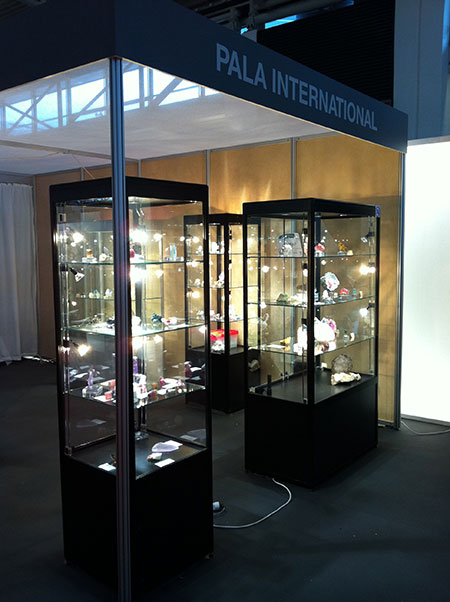 |
| Pala & Pals. Pala shared space with Christophe Gobin and Alain Martaud. (Photos: Will Larson) |
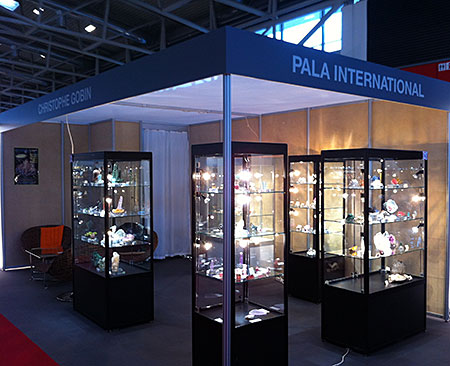 |
Sales were fine considering the European Union’s current state of uncertainty with Greece and Italy constantly keeping everyone on their toes. I was able to acquire a few very nice specimens this trip. Czech Republic’s KARP and Russian dealers continue to bring out some very interesting cuprites and coppers from Siberia. In particular this time there were really great pseudomorph coppers after cuprites. I was also able to obtain one of the best anglesites I’ve ever seen from Morocco. My father and I have nicknamed it the Moroccan Sun.
Speaking of the EU, this year’s special exhibit was European classic minerals and the display was fantastic! I really enjoyed seeing some very fine specimens from museums from all around Europe and from the private collectors that displayed their minerals.
Some of my favorite highlights from the special exhibit were the Norwegian Mining Museum’s grand display of Kongsberg silvers. These silvers crush most other silvers I have seen in person and captivated my attention. The British Museum was kind enough to bring some of their very best minerals from London, including one of the finest large jordanites I’ve ever seen. And one of my favorite pieces in their collection: the light yellow fluorite cubes on white quartz matrix from the West Caradon Mine in Cornwall. (Both pictured below.)
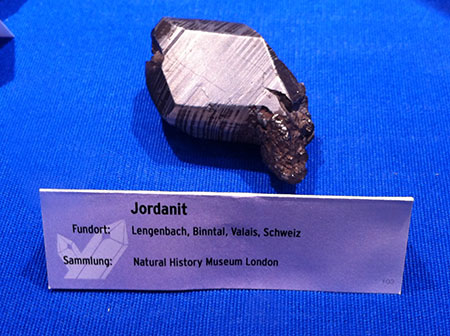 |
| Brit hits. Above, a jordanite from Switzerland’s Lengenbach Quarry (which has its own website). Below, pale yellow fluorite cubes are perched on snow-white quartz crystals, from the West Caradon Mine, Cornwall, England. Click to enlarge. (Photos: Will Larson) |
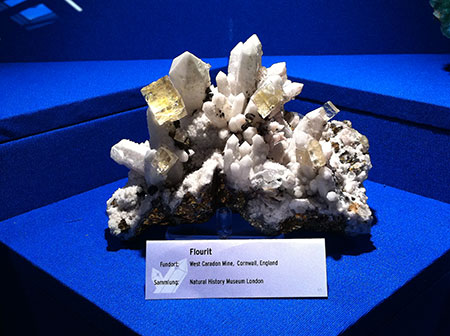 |
Two very fine gwindles (quartz) shared a case; Marcus Budil’s tall clear gwindle and Eric Long’s very beautiful smoky quartz matrix. There was devilline and glaucodot from Paul Stahl’s collection. The National Museum of Natural History of France brought a killer Greek smithsonite from Laurium. Vienna’s Museum of Natural History brought a killer euchroite and one of the best copper specimens from Germany as well as the best hessite specimen I’ve seen. Erika Pohl-Stroher lent one of the finest Germany mimetite matrixes from Saxony.
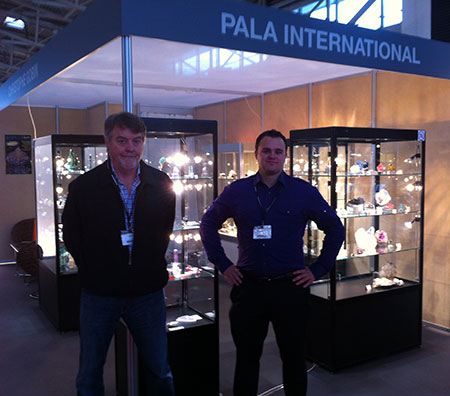 |
| Auf dem Display. Pala’s Bill Larson and Will Larson stand before 200+ specimens offered by three dealers at the Munich Show. |
The catalog for the 2011 show is still available as are catalogs for several other years. And be sure to see two specimens from the show, which we feature here.
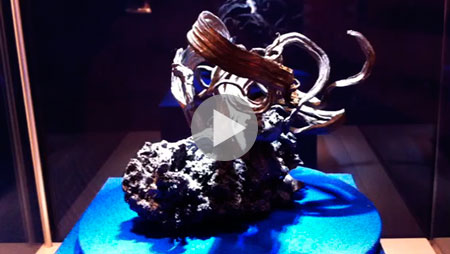 |
| Kino. See a brief streaming video of one of the Kongsberg silvers. |
[back to top]
Pala International News
Pala’s Featured Specimens: Macedonian Ruby
and Namibian Aquamarine
This month we feature a couple of new specimens acquired at the recent Munich.
The first is a massive ruby from Macedonia with defined crystal structure and an intense pinkish red hue. Pala bought a small selection of these stunning rubies, this one being the finest and largest of the group. This 425-gram hunk of ruby consists of two main crystals and multiple secondary clusters.
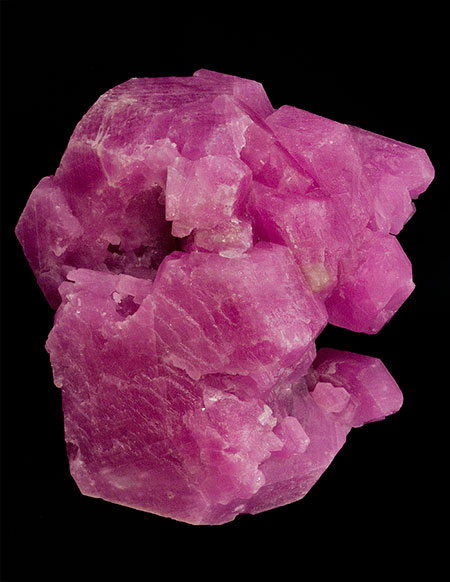 |
| Macedonian Ruby, 7 x 6.5 x 5 cm. Price available upon request. (Photo: Mia Dixon) |
Another fun and large specimen unearthed at the show was this aquamarine and white-capped quartz from Erongo, Namibia. Several terminated aquamarines seem to dive into and leap out of the quartz host. Not a pristine specimen, but kind of a dirty, manly rock. For those collectors who like their specimens a little raw and rugged.
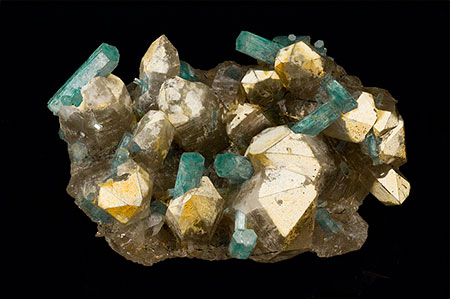 |
| Namibian Aquamarine, 13 x 8 x 7 cm. Price available upon request. Click to enlarge. (Photo: Mia Dixon) |
New Kid on the Blog
Pala acquires the Mountain Lily Mine
Our mining weblog, blog.Palaminerals.com, has several new entries. Among them are the plats for the Esmeralda Mine and for the Mountain Lily Mine, Pala International’s newest acquisition.
The Mountain Lily Mine, a mile east of the Aguanga Mountain summit in San Diego County, is known by other names such as the Ware and Emeralite No. 2. It was discovered in 1902 by an Oak Grove prospector, Bert Simmons. We’ll bring more information on the mine in the coming weeks.
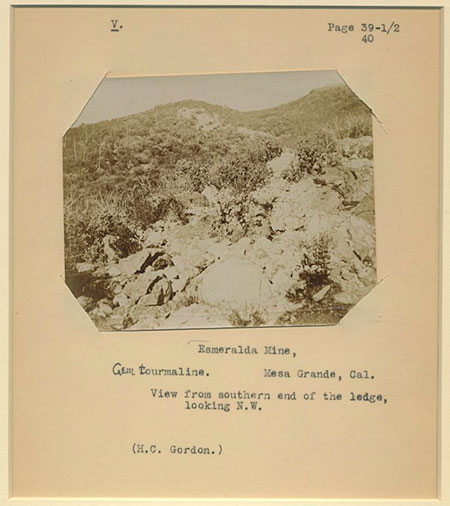 |
| Also on the blog are two enlarged photos by H. C. Gordon of the Esmeralda Mine. Gordon’s photographs were featured in G. F. Kunz’s “Gems, jewelers’ materials, and ornamental stones of California,” California State Mining Bureau Bulletin, Vol. 37, p. 171. This photo, in the collection of Bill Larson, was acquired from the Kunz estate. |
[back to top]
Mineral and Mineralogy News
Andesine Alley
New and older examinations of Tibetan material
Last month, as we informed readers of our sister e-newsletter, Palagems Reflective Index, Richard W. Hughes posted the second installment in a trilogy of probes and pensées on the subject of the mining of natural red andesine in Tibet. (See our “Ten Years in Tibet: Andesine Lost and Found.”)
This summer, Hughes contributed, along with eleven co-authors, to “Research on Gem Feldspar from the Shigatse Region of Tibet,” the feature article in Gems & Gemology’s edition otherwise devoted to the proceedings of the 5th International Gemological Symposium held in May. (See our write-up on this edition of G&G.)
Three of the co-authors, Shane F. McClure, George R. Rossman and Kenneth Scarratt, issued a study of andesine matrix, dated August 1, which concluded… well, we wouldn’t want to spoil it for you. See “A Study of Andesine Matrix Specimens Purported to be from Tibet.”
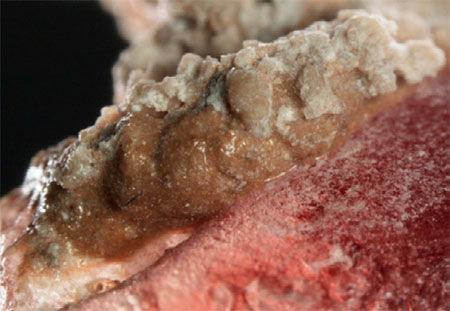 |
| Suspicious finds? This image (field of view 4.0 mm), from “A Study of Andesine Matrix…,” shows that “contact material found where the andesine and matrix met often had the appearance of ‘wetting’ the matrix, filling in the porosity and making it look shiny.” (Photomicrograph by S. F. McClure. © GIA. Reprinted by permission.) |
[back to top]
Industry News
Web World
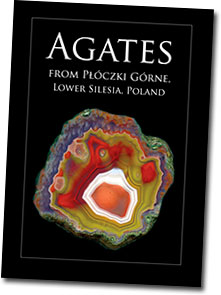 |
| Agates… was published by by the Spirifer Geological Society. |
Poland
Two websites might be of interest to mineral folk. SpiriferMinerals.com is the site for the Spirifer Geological Society, which was involved with the Mindat Conference 2011 in Lwowek Slaski, Poland. (See photos of the conference here. The next conference is in Midelt, Morocco.)
The website features sales and auctions as well as recollections of field trips to destinations such as the Balkans, Greece, the Alps and Morocco. Articles cover subjects like crocoite in Tasmania, a look at the book Agates from Plóczki Górne, Lower Silesia, Poland, and a movie regarding the discovery of amazing multiply-twinned calcites in Madagascar.
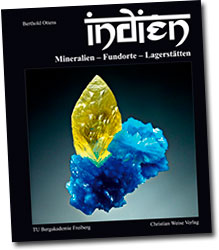 |
| Indien… by Berthold Ottens features a Deccan Traps calcite on cavansite on the cover. |
Belgium
Field trips also are recounted on GeonicMineralenCollectie.be, the website for the Georges Claeys’s Geonic Minerals Collection in Ghent, Belgium (translated from Dutch here). For instance, a 2008 visit to the Deccan Traps area of central India. The term trap is derived from the Swedish trapp, a variant for “staircase,” which suits the step-like basalt hills of this region, one of the largest volcanic formations on earth. A visit to Florida last year looked at the state stone—agatized coral. Also, a report from this year’s Munich Show. Specimens from particular and mixed localities are offered.
[back to top]
Light Show: Backlit Onyx
Try as we might, when visiting the Twin Cities it’s not always easy to forego the call of the Mall. In October we took refuge from the din of the MOA corridors to the din of the dining room—there literally was no relief at rush-hour on a Friday—at Crave, which for the past 30 months has occupied the old (and quieter) California Cafe space. The furnishings are cuprian—literally and figuratively—and if you sit at the sushi bar you’ll be bathed in the saffron glow of a backlit onyx wall.
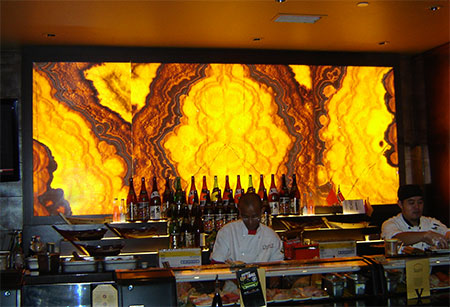 |
Backlit onyx is used in many locations, such as the Four Seasons Westlake Village, Introbar at Singapore’s Equinox Complex, and in this unnamed location.
Blank box
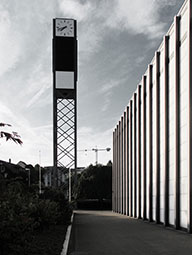 |
| Photo by Carlo Fumarola. See more here. |
All of this brings back memories. Your editor was fortunate enough to sing with an American choir in Pius Church in Meggen, Switzerland, on Lake Lucerne. But this being our first stop on a tour that would have us concertize even in architectural landmarks such as St. Mark’s in Venice, we were horrified. From outside, the church appeared to be a warehouse or public works building. Its panels looked like pre-fab concrete slabs but actually are 28-mm-thick slices of white marble from Penteli Mountain, the same source used in building the Acropolis. Inside, especially at sunset, it became clear why the Piuskirche had been chosen as a venue for our choir. Some digital photographs from the sanctuary capture a a wild, amber display, but our recollection is more along the lines of these, from the German architectural journal DETAIL. [back to top]
Pala Presents
The Igneous Rocks of the Mogok Stone Tract
A PhD Dissertation by Kyaw Thu
With Pala Presents, we offer selections from the library of Pala International’s Bill Larson, who will share with us some of the wealth of information in the realm of minerals and mineralogy. While much of the writing will be of a certain vintage, more recent material also will be presented from Pala’s colleagues around the world.
Bill Larson told us the following about Kyaw Thu, whose PhD dissertation is the first in our Pala Presents series.
Kyaw Thu is a FGA gemologist with a Ph.D. in Geology. Pala international knows him from trips in the mid-1990s as one of the most interesting young gem enthusiasts, among so many wonderful students and collectors we met. Both Will and Bill Larson consider him a special and close friend. He has helped answer many questions regarding locality information for Brendan Laurs of GIA as well as meeting in person Dr. George Harlow of the American Museum of Natural History and corresponding with him for almost a decade. He has opened a gem laboratory and has applied to GIA to further his education. I was given a copy of his PhD thesis last month and Dr. Harlow made it available by scan for interested parties. Pala International is honored to share this with our readers.
Kyaw Thu completed his dissertation at the University of Yangon in 2007. The full title is “The Igneous Rocks of the Mogok Stone Tract: Their Distributions, Petrography, Petrochemistry, Sequence, Geochronology and Economic Geology.” For this edition of our newsletter we present the first two chapters, Introduction, and Geology of the Area, as well as References. These are preceded by an abstract and acknowledgements. Access the dissertation here.
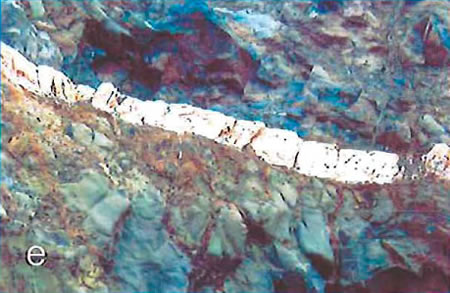 |
| From Fig. 2.10. Pegmatite dyke in peridotite and chrysoprase veins in upper part of photo, Mya-sein Taung. (Photo © Kyaw Thu) |
Many fine specimens are covered in upcoming chapters. Our next installment will feature Chapter III Petrography, and Chapter IV Petrochemistry.
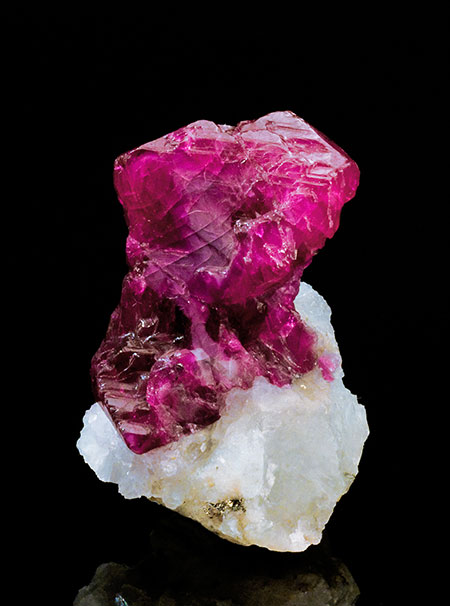 |
| Mogok ruby. From the Pala International Corundum Collection. (Photo: Mia Dixon) |
[back to top]
Recycle Bin
Two items from last month’s sister publication, Palagems Reflective Index, will be of interest to mineralophiles.
Phenomena in Norwegian Peridot
We recently received a note from Norwegian mineralogist Reidar Åmli regarding “some old material in my collection, some small pieces of peridot containing cat’s eye effect.” Because cat’s-eye and star peridot is relatively rare, we received permission to publish photographs, and received images of two more specimens.
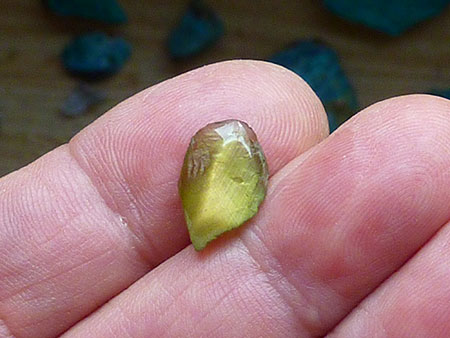 |
| Cat’s eye. Originally, Reidar Åmli described the phenomenon in this peridot specimen, illuminated by daylight above and halogen light below, as cat’s eye (chatoyancy). Pala’s Bill Larson opined that a cabochon of this material, if properly oriented, could display a four-rayed star, though so far, Åmli has not observed this in the stones in his collection. (Photos: Reidar Åmli) |
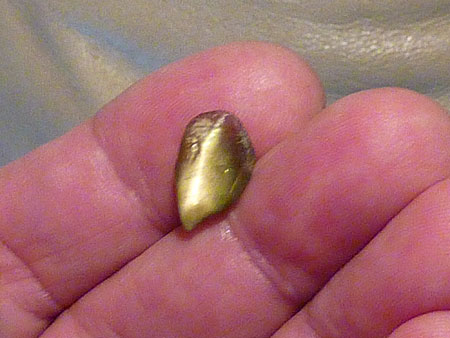 |
The above stone, 5.58 carats, was collected in the Åheim olivine mine, located south of Ålesund, Norway. The mine, described for a 2008 excursion as part of the International Geologic Congress, is at the largest commercial olivine deposit in the world, with potential production of over 400 years. Peridot is the green gem variety of olivine.
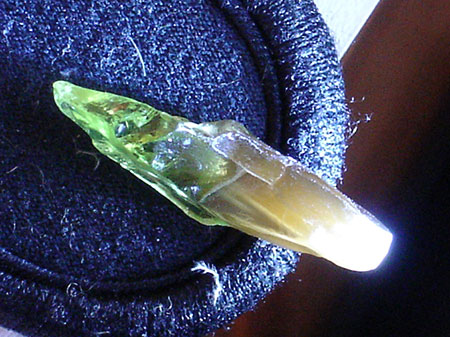 |
| Scattering photons? Transmitted light shows, according to Åmli, “the transition from normal peridot to this variety. However, I believe it is more a question of schiller rather than true cat's eye.” (Photo: Reidar Åmli) |
The adjective chatoyant in English comes from the present participle in French, chatoyant. The Micro Robert French dictionary defines it as: Qui a des reflets vifs et changeants (“That which has sharp and changing reflections”). The French word derives from chat (“cat”) and oeil (“eye”), i.e., the reflective quality of a cat’s eye. In gemstones, the phenomenon is caused by the material’s fibrous structure or by linearly oriented inclusions. When it is displayed via a cabochon cut, the fibers/inclusions run parallel to the stone’s base, and the distinctive gleaming streak runs perpendicular to their direction, just as is seen when light strikes a spool of silk thread. In reports of rare chatoyant peridot, these inclusions have been observed to be dendritic while others are thin and rectangular (G&G, Summer 1987) and have even been observed in chatoyant pallasitic peridot as parallel tube-like inclusions (G&G, Summer 2008). Chatoyancy is exemplified by the gem known simply as cat’s eye, as seen in our October 2009 featured stone, a round 13.25-carat chrysoberyl cat’s eye, which showed how two light sources could cause the eye to “wink.” This razor-sharp eye is due to the sheer density and fineness of extremely tiny acicular growth tubes. (PhotoAtlas Vol. 1).
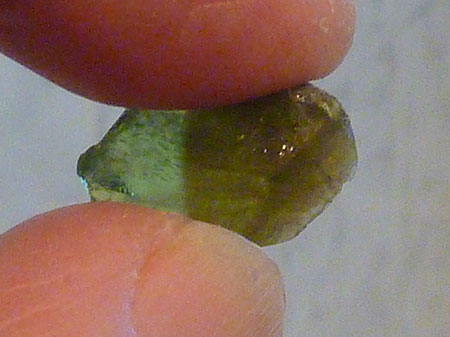 |
| Phenomenal mysteries? Åmli characterized the display in this 13.8-carat peridot as adularescence or scattering of light. When observing this specimen while changing orientation of the light (images above and below), Åmli questioned whether adularescence might also be applied to the first specimen above. (Photos: Reidar Åmli) |
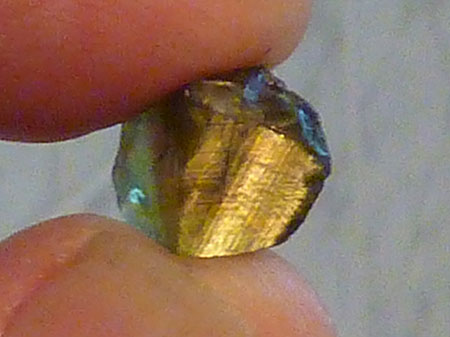 |
It’s possible for optical phenomena to co-exist, such as in feldspar sunstone like this cabochon that exhibits aventurescence, adularescence and asterism.
We’ve had nomenclature discussions before (“Feldspar, Fastidiously”), so if you have thoughts on what may be going on in this peridot, email us with feedback. [back to top]
Midnight Sunstone
A new study looks at navigation by twilight
You float on the sea/ Sleep on the surface/ Light through the fog
—Sigur Rós, “Ára bátur” (“Row boat”)
On November 1, BBC pointed to a new new study of “Viking sunstone” and its application by navigators under conditions such as starless summer nights and foggy days. “Icelandic rocks could have steered Vikings,” the article’s headline declared, and it was accompanied by a photograph of seven orange-hued cabochons. We (and many others, as it turns out) knew of Elise Skalwold’s interest in this material, which we reported in June 2009, in Pala Mineralis.
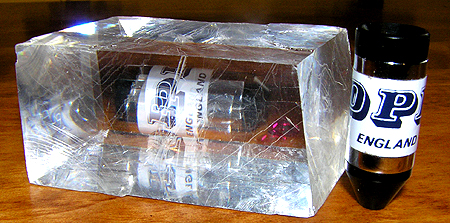 |
| Double duty. Objects viewed through the calcite appear double. Each image represents one of the rays of light which has been split off and polarized by passing through the doubly refractive calcite. (Photo: Elise Skalwold) |
We should remark that “Icelandic rocks” is not very descriptive of any of the possible minerals thought to be the Viking sunstone referred to in the ancient Sagas; the two most likely suspects are optical calcite and iolite (the gem variety of cordierite). The latter is a strongly pleochroic mineral, sometimes referred to as Viking Compass, while the former is well-known for its ability to show strong doubling. Sunstone (or Solstenen) refers to its navigational utility and should not be confused with varieties of feldspar, such as the orange-hued aventurescent stones pictured in the BBC article. The Telegraph, for its part, used the correct material in its photo.
The new study, “A depolarizer as a possible precise sunstone for Viking navigation by polarized skylight,” published in Proceedings of the Royal Society A, was conducted by an international team led by Guy Ropars of the Université de Rennes, in France. The study concluded that Viking navigators could have determined the direction of the Sun by using birefringent crystals as polarizers, under conditions such as cloud cover and even twilight. (A previous study, published in the same journal in 2007, also examined the method’s efficacy under foggy and cloudy skies.) See Discovery Channel’s Discovery News for the study’s highlights and an excellent description of how the crystals could have been used.
As Discovery News pointed out, no Iceland spar (calcite) has been found in excavations of Viking villages. But even centuries after the advent of the magnetic compass, it’s possible that such a crystal was used: an Iceland spar was found in the remains of the late 16th-century ship now referred to as the Alderney Elizabethan Wreck, as first reported in Leif Karlsen’s Secrets of the Viking Navigators (about which, more below).
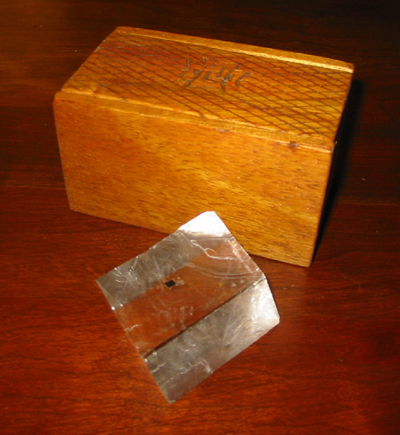 |
| Spot-on. This unpolished cleavage rhomb was obtained by Leif Karlsen in Iceland from an unknown locality. It is shown with a box he carved to protect this fragile specimen with its famous easy cleavage. The black spot is a bit of tape applied for navigation experiments. (Photo: Elise Skalwold) |
As a response to the many notices sent to Elise Skalwold regarding the new study, she posted her take on the subject in MailTalk, Gem-A’s email forum, which reads in part:
While some use the idea to romance the stone (such as iolite), I’ve always thought it was a great teaching model for polarization, pleochroism and birefringence—as well as reaching into other areas of study. A professor here at Cornell Univ. is teaching a class in archaeological navigation, including the Viking sunstone and I’ve hoped to use it in a gemmology/mineralogy related program here as well. There is a long list of interesting references at the bottom of [my “Fabled Viking Sunstone”] page, pro and con…
Elise then pointed to an article in the October 2011 edition of Elements, titled “Tourmaline the Indicator Mineral: From Atomic Arrangement to Viking Navigation,” by University of Manitoba’s Frank C. Hawthorne and GIA’s Dona M. Dirlam. This article (as Elise likewise noted on her own “Fabled Viking Sunstone” page) suggests three strong possibilities for crystal material whose navigational avail originally was mentioned in a medieval Icelandic saga legend. The candidates: tourmaline (probably elbaite), cordierite (aka iolite) and calcite. (Elise also mentions the highly pleochroic andalusite.) Cited by all three scholars is Leif Karlsen’s Secrets of the Viking Navigators, a book that Elise feels “makes a very strong case” for calcite due to the abundance of optical-quality material, “which can even be found in the surface scree.” For more on a famous mine in eastern Iceland, see Leo Kristjansson’s 2002 article from Journal of Geoscience Education, “Iceland spar: The Helgustadir Calcite Locality and its Influence on the Development of Science.” For photos of the locality, see The Giant Crystal Project and a companion locality page, both hosted by The Strahlen Foundation.
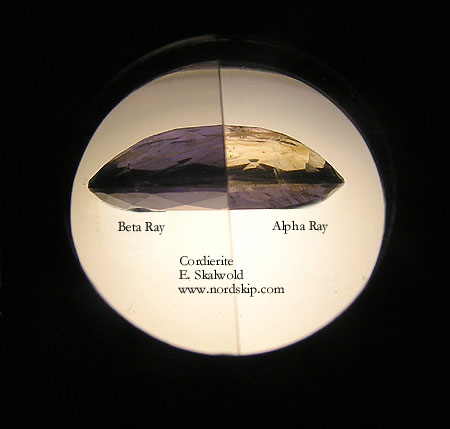 |
| Shifty. Pleochroism demonstrated in cordierite, variety iolite. An illustration of trichroism in this stone, via gamma ray, can be seen here. (Photo: Elise Skalwold) |
Sunstone and Sunstone
A stone with which one could see where the sun was in Heaven.
—From St. Olav’s Saga
The Elements article bases its discussion of optics on the above-mentioned 2007 study, which was led by Ramón Hegedüs of Budapest’s Eötvös University; the study is available now in its entirety. Of most interest to colored gemstone lovers would be pleochroism in iolite/cordierite, as illustrated above. As Elise mentions in her discussion of the subject, iolite-as-Viking Compass was the theory favored, as early as 1967, by Danish archeologist Thorkild Ramskou who in fact coined the term. But calibration in order to find the direction of the sun (in cloud cover) would have presented a challenge.
One region in Norway famous for cordierite, especially the classic (and now emptied) locality of Østerådalen, according to Mindat, also happens to be famous for aventurine feldspar—aka sunstone. [back to top]
— End December Newsletter • Published 12/2/11 —
October 2011 Newsletter
In this edition of Pala Mineralis we enter the blogosphere with (where did they come up with that name?) blog.Palaminerals.com, the vehicle by which to keep on top of Pala International’s newest mining ventures. We begin with a virtual visit to the Esmeralda Mine, including some background from John Sinkankas and a tie-in to a notorious Chinese regent.
Shows and Exhibitions
- Pala to Show in Munich October 28–30, 2011
- Paris in the Fall: 40th Salon Inernational December 2–4, 2011
- Dal’negorsk in Denver
Pala International News
- Pala’s Featured Mineral Specimen
- Pala Mining Blog Goes Live
- Royal Ravage – Tourmaline Queen in Flames
Mineral and Mineralogy News Briefs
- News Briefs
- Tiny fossils…
- Also from Down Under…
- The aliens brought it
- Down-to-Earth: The Geode House
Recycle Bin
Shows and Exhibitions
Mineralientage München 48th Munich Mineral Show
October 28–30, 2011
Pala International will be in Hall A6 Pavilion Booth 29
 |
Pala International will be offering fine mineral specimens at this year’s Munich Show.
When: October 28–30, 2011
Where: Munich Trade Fair Centre
Hours:
Friday, October 28: 9:00 AM – 7:00 PM (Trade only)
Saturday, October 29: 9:00 AM – 7:00 PM
Sunday, October 30: 9:00 AM – 6:00 PM
Booth: Hall A6 Pavilion Booth 29
This year’s special exhibit is titled “European Classics 2011,” which brings to the show treasures from some of the most renowned museums and private collections, including the tourmalines from Elba, in the Tuscan Archipelago; hessite from the Museum of Natural History Vienna; fifty specimens leaving the British Museum of Natural History for the first time; Kongsberg silvers from Norway and gold specimens from Romania; and many more. See a streaming video overview here.
For more information visit the show website. See the Pala International Show Schedule for future events. [back to top]
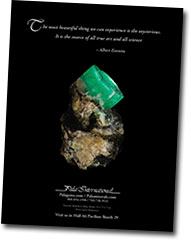 |
| See our ad in this year’s program. |
[back to top]
Paris in the Fall: 40th Salon International –
Minerals, Fossils, Gems & Jewelry
Pala provides poster child for pre-holidays show
More than 150 exhibitors from over 20 countries are slated to participate in the 40th International Exhibition of Jewelry and Mineralogy of Paris, December 2–4, 2011.
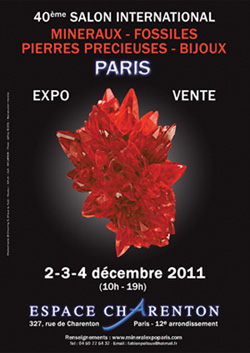 |
| Wanted Poster. From the collection of Pala’s Bill Larson, this rhodochrosite hails from the N’Chwaning II Mine in South Africa, photo by Jeff Scovil. |
The show takes place in central Paris’s 12th arrondissement at Espace Charenton. It includes participation by several organizations, institutions and publications. Can’t make it in December? A fair takes place in the spring, too. [back to top]
Dal’negorsk in Denver
“Minerals of Russia” took center stage at the 44th Annual Denver Gem and Mineral Show in September. Here’s a tiny taste.
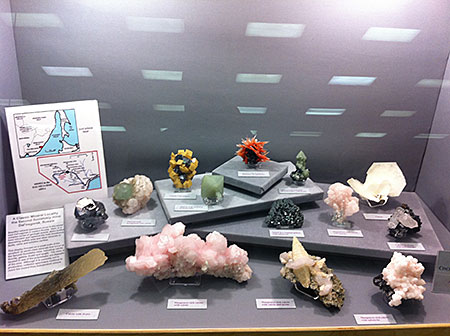 |
| Mineral mélange. Exhibit of specimens from the Second Sovietskiy Mine in Russia’s Dal’negorsk, site of Naica-like giant crystals. The variety of specimens from this single locality (calcites, fluorites, quartz, galena) mirrors the diverse ethnicities that made up the Sovietskiy narod—the USSR as an undivided nation or people—which, of course, came apart at the seams. Click to enlarge. (Photos: Will Larson) |
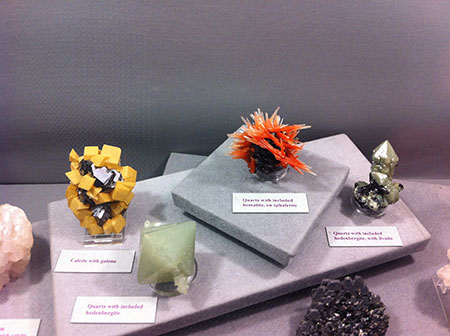 |
Some people have all the luck…
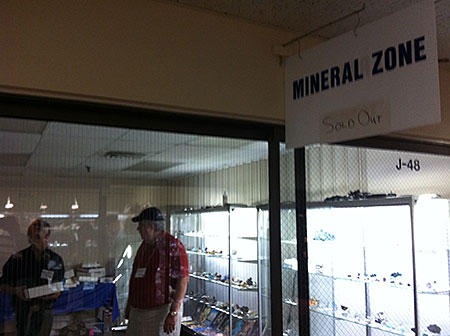 |
| Sweet sign. Tucson’s Marcus Origlieri, left, packs up early. (Photo: Will Larson) |
Where there’s wine…
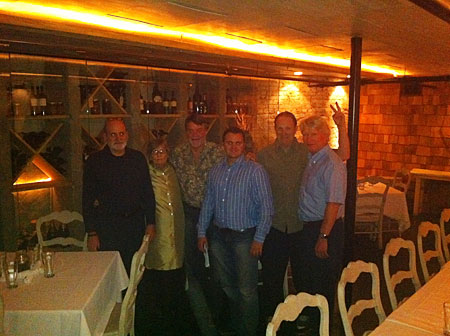 |
| Zombie Crawl? No, this is not taken from Denver’s notorious monster masque. Left to right, news editor David Hughes and helpmeet Andrea Carney, Bill Larson, Will Larson, prospective Pala prospector Casey Jones (would you trust this guy with heavy machinery?), and John McLean. |
[back to top]
Pala International News
Pala’s Featured Specimen: Alexandrite from Zimbabwe
This month we feature a phenomenal specimen from the Girdlestone claim in central Zimbabwe.
This is an exceptional alexandrite sixling with well defined arms and multiple crystalline structures running throughout the specimen. The most impressive aspect of the piece is the drastic color change from an emerald green in daylight to a reddish-purple in incandescent light. This is a color change comparable to the great faceted Russian alexandrites we all hear about but never get to see in person because mining is long gone, and the few such stones are hidden deep in old collections.
This is a great opportunity to capture a truly unique and phenomenal specimen. Zimbabwe alexandrite combines exceptional color change along with well formed crystals.
Pala Mining Blog Goes Live
blog.Palaminerals.com takes you to the Esmeralda Mine and more
Visit Pala’s new blog devoted to the development of our mining ventures, blog.Palaminerals.com. The lineup so far includes:
- On the Road to the Esmeralda Mine, as the Pala staff are given the wrong keys to the forestry service gate, having to hoof it in the August heat
- Sinkankas Notebook: The late, great John Sinkankas visited the Esmeralda Mine exactly 45 years ago; we feature the notes on his two trips to the mine
- Empress Dowager: Passion for Pink, regarding the current Smithsonian exhibition of the only photographs of the Chinese regent who kept a SoCal industry in the pink
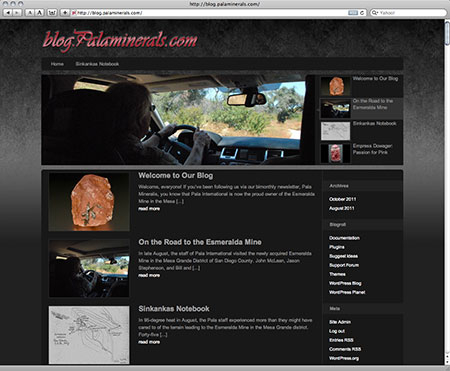 |
Feel free to use the blog’s comment feature to leave feedback or ask questions. We’ll be refining other features in the coming days. The blog is built in WordPress, so if there's a plug-in you’d care to suggest, or something’s not working, don’t hesitate to email the editor.
Royal Ravage – Tourmaline Queen in Flames
Did we mention it was hot at the mines in August? You’ll want to read an eyewitness report by Eric Cordova of San Diego Mining Company, who provided us with a report on the Tourmaline Queen Mountain Fire of August 29 and 30.
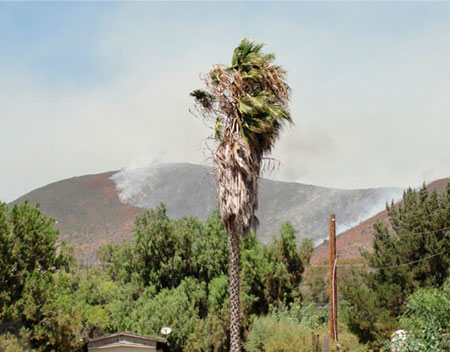 |
| Sovereign sizzles. Tourmaline Queen Mountain in flames in the early afternoon of August 29. Vegetation there hadn’t burned since the 1960s, according to a local authority. (Photo: Erik Cordova and Scott Ritchie, San Diego Mining Company) |
The Stewart Mine, one of three that are mentioned in report on the fire, was spared. Coincidentally, on the day the blaze broke out, we scanned the photo below, which Pala’s Bill Larson had just acquired. Taken at the Stewart Mine in 1969, it includes Martin Ehrmann, who wrote an unpublished account of his time in Burma (1955–1962) dealing in colored gemstones. Pala International was given permission by Ehrmann’s son Herb to post the six-chapter manuscript, The Ruby Mines of Mogok, on Palagems.com. In Chapter 5, Ehrmann accompanies Dr. Vic Meen, curator of gems and minerals at the Royal Ontario Museum, to Mogok and Mogaung on a hunt for museum-quality specimens. As a bonus, we received permission to reprint Ehrmann’s “Gem Mining in Burma,” from the Spring 1957 edition of Gems & Gemology.
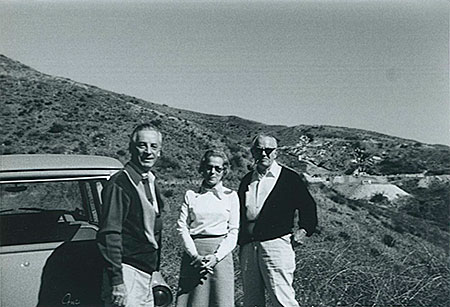 |
| Legends at the ’Lithia. Martin Ehrmann, right, accompanies Dr. and Mrs. Hugo Strunz to the “Mine Bash” at the Stewart Lithia Mine on November 18, 1969. In 1941, Karl Hugo Strunz published his Mineralogische Tabellen (Mineralogical Tables) classic, a crystal classification system that he developed while curator of the Mineralogisches Museum in Berlin. The system is now maintained at Mindat.org. (Photo from the collection of Bill Larson) |
[back to top]
Mineral and Mineralogy News Briefs
News Briefs
Tiny fossils (tiny fossils)
In the brine…
Microfossils have convinced scientists that anaerobic bacteria lived over 3.4 billion years ago. Sulphur isotopes from rocks in Western Australia suggest that the microbes were sulphur-based and ocean-dwelling. Pyrite is identified as the metabolic byproduct of these multicelled minis in the sandstones being studied, the signs are right for life—a life that flourished in air filled with methane and CO2. Read about it at BBC or the journal Nature Geoscience.
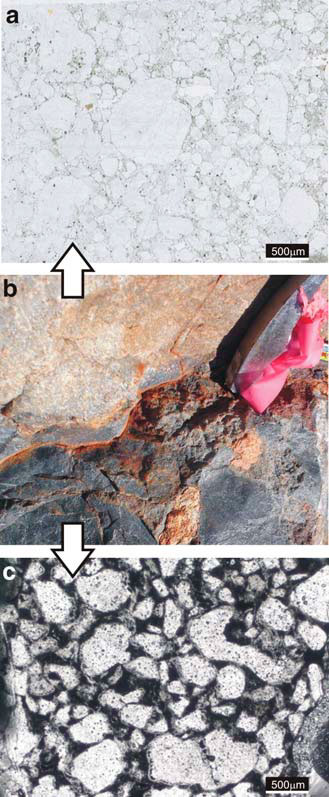 |
| Pyrite poo? The middle image of an outcrop at Six Mile Ridge displays dark, carbon/pyrite-rich sandstone below, with photomicrograph c. Pale, carbon/pyrite-poor sandstone, above, with photomicrograph a. (Images from Supplementary Information, Nature Geoscience) |
Also from Down Under…
Australians in the aptly named Goldfields, also in Western Australia, are taking advantage of the high price these days, according to an August 29 story in the Wall Street Journal. Already in the first six months of this year more than 100 more licenses had been issued to small-time prospectors than in all of 2006, when the last rush took place, with gold a mere $600 an ounce. The gold field was formed 2.6 billion years ago when gold-bearing magma was stirred by a series of earthquakes. (But what about the cute little microbes?)
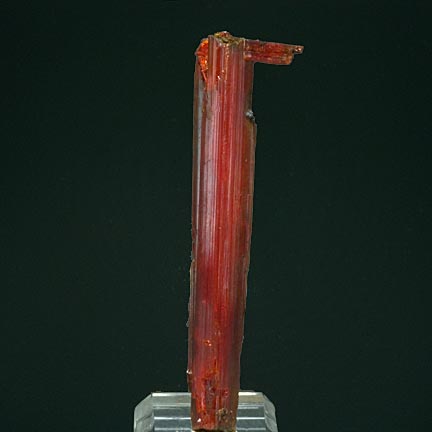 |
| From Down-Down Under. Here’s a crocolite from the Read Lead Mine, Dundas, Tasmania. It’s from an old collection with a label from J. Hoppner. Inventory #18707. (Photo: John McLean) |
The aliens brought it
So from whence exactly did this magma come? Researchers at the University of Bristol believe that the Earth has far too much of the stuff, while it should be “bereft of bling” (their phrase, not ours). During the planet’s formation, molten iron sank to the its center, and along with it most of our world’s precious metals. A theory had proposed that the Earth’s mantle had collected gold after the core formed, from “a cataclysmic meteorite shower”; the U of B scientists went about testing the theory. They looked at rocks a bit older than the stories above, nearly 4 billion years old, from Greenland (Up Over?). From these, tungsten isotopes were key, because tungsten is quite rare and, like gold and platinum, should have been carried into the core. The Greenland rocks had a 15 parts per million decrease in the isotope 182W, from “modern day rocks.” The increase found in the mineralogical spring chickens, it is thought, is the result of “20 billion billion tonnes of asteroidal material,” including precious metals. The study was published in Nature.
Down-to-Earth: The Geode House
Looking like something encrusted with Atlantean barnacles, a quartz-lined geode-covered house in Aguascalientes City, central Mexico, is sure to bring a coche or two to a screeching alto. Geodes didn’t come from the sky; the name literally means “earthy.” Tucson’s Peter Megaw posted photos of the house on FMF Minerals Forum, for which he is co-moderator. The photographer is his friend, Abelardo Mendevil, a geologist in Mexico, to whom we are grateful for permission to include a sample here.
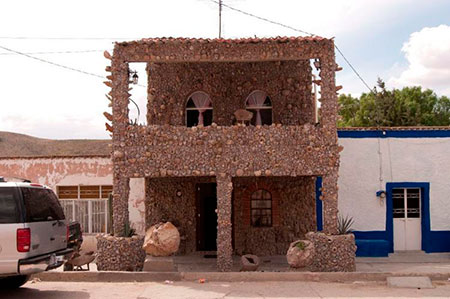 |
| Mansión Mineral. Earthy, indeed. (Photo: Abelardo Mendevil) |
You simply must see the pièce de résistance, as Peter has so fittingly characterized the last photo in the series, available here. [back to top]
Recycle Bin
The Spider and the CT Scan
We included the following in our sister e-newsletter, Palagems Reflective Index, as a companion to our September featured gemstones—faceted amber.
Our featured ambers are bright and clean. But ever wonder what might be lurking within less desireable material? A tiny specimen housed at the Natural History Museum in Berlin held an obscure outline, barely visible even under a microscope. The specimen was one of many from the mid-19th century collection of Georg Karl Berendt, and was said to include the oldest example of a so-called huntsman spider (family Sparassidae). The specimen in question raised doubts, however. Huntsman spiders, which today live in the tropics and southern Europe, can have a legspan of nearly twelve inches, meaning that only rarely are they trapped by tree resin. Nevertheless, the researchers, using X-ray computed tomography, which provided the detail they needed, verified this to be the oldest huntsman—49 million years old.
“The research is particularly exciting because our results show that this method works and that other scientifically important specimens in historical pieces of darkened amber can be investigated and compared to their living relatives in the same way,” said Dr David Penney, from Manchester’s Faculty of Life Sciences.
Read more on the discovery at The University of Manchester and MSNBC. The study was published in June by Naturwissenschaften.
Fossilized Feathers
See also “Dinosaur feather evolution trapped in Canadian amber” at the BBC regarding a new study published in Science. [back to top]
Fruit of the Mine: Jewels and Wine
The Coghlan family, purveyors of Cabs and cabs
The following appeared in the August edition of Palagems Reflective Index.
Saint Agnes is the patron saint of, among other things, gardeners. Saint Barbara is venerated by miners. So it’s appropriate that the Santa Ynez Valley, in Santa Barbara County, would be home to Coghlan Vineyard & Jewelers. This third-generation enterprise, has 55 years in the jewelry business. And to the pursuits of jewelry and gemology have been added viticulture and enology. According to a local vintners’ association listing, the Coghlan estate vineyard, on a knoll facing southwest in the eastern section of the Valley,
serves for the ideal climate conditions in their specific micro-area that is of particular benefit to Bordeaux and Rhone-type varietals. In addition, the property’s rock and loam soil types and well-drained hillsides result in a terroir of remarkable potential. In 2003, ten acres of vines were planted to four different clones of Cabernet Sauvignon and the first harvest was in 2007. In 2010, nine more acres were planted to Grenache Blanc, Grenache, Malbec, Petit Verdot and Cabernet Franc. The addition of these varietals will broaden the estate’s diversity and ultimately enhance the Coghlan portfolio of wines.
The Coghlans also employ Pinot Noir grapes from single vineyards on the western end of the Valley, carrying the appellation Sta. Rita Hills (between Lompoc and Buellton) and fruit from their premium vineyard in the Happy Canyon area at the Valley’s eastern end.
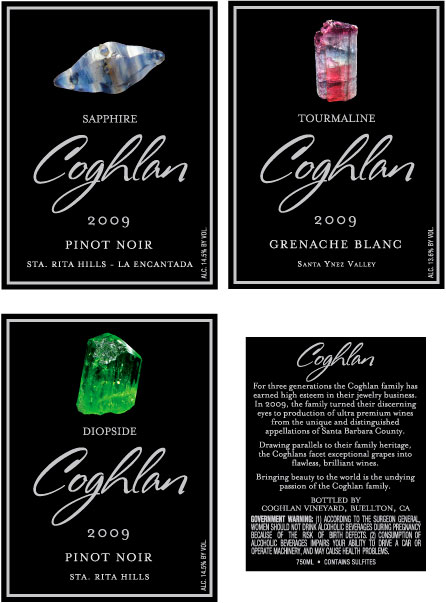 |
| Gemmy, jammy. Labels from the Coghlan collection of fine wines from the Santa Ynez Valley, which feature images of fine mineral specimens: a double-terminated blue sapphire crystal from Sri Lanka, a bi-color tourmaline from Brazil, and a rare diopside crystal from the Merelani (tanzanite) mine in Tanzania. We hope for more! |
The family has transformed an historic Victorian home in Los Olivos into a showroom for both their jewelry and their wines, which carry the names Sapphire (Pinot Noir, Sta. Rita Hills–La Encantada), Tourmaline (Grenache Blanc, Santa Ynez Valley), and Diopside (Pinot Noir, Sta. Rita Hills). Somos encantadas…
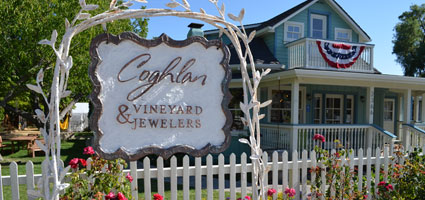 |
[back to top]
— End October Newsletter • Published 10/5/11 —
September News
September 2: Royal Ravage – Tourmaline Queen in Flames
Pala District’s 350-acre fire claims historic claim
Nature marked the lead-up to the Labor Day weekend with several wildfires in Southern California. The largest, still burning on Tuesday, but eventually contained, charred 350 acres in the area between the mining monarchs of San Diego County’s Pala District—the Tourmaline King and Tourmaline Queen.
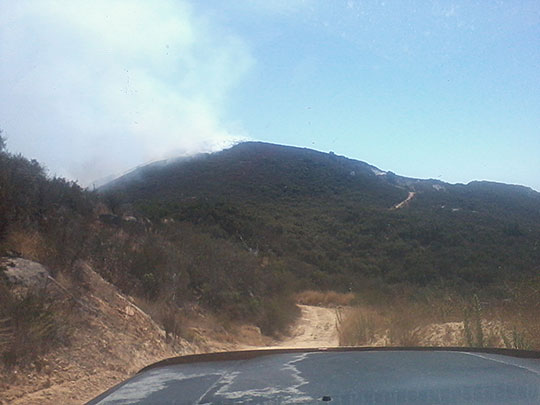 |
| On top of old smoky. The north access road to the Tourmaline King and Queen Mines leads to the fire in the photo, taken a little after 2:00, August 29. The King was spared, while the Queen was not. If you looked in a different direction, you might have seen a 160-acre grass fire in the town of Murietta. (Photo: Erik Cordova and Scott Ritchie, San Diego Mining Company) |
The challenge to firefighters was a combination of steep terrain and vegetation that hadn’t burned since the 1960s, according to Cal Fire’s Ray Cheney, as reported by Channel 5 in San Diego on Tuesday. Tuesday morning’s marine layer provided relief, and the fire was contained. But not before consuming almost all of the brush at the Tourmaline Queen (the mine had no structures to burn), which has been operated only intermittently following its heyday over 100 years ago. (The mine saw more glory in the 1970s; see “The Queen Reigns Again.”)
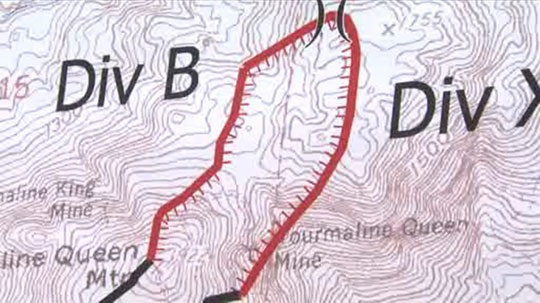 |
| King and Queen. This map was displayed in an August 30 broadcast from San Diego’s Channel 5. Cal Fire’s Ray Cheney explained that the red outline above, which delineated the open fire line, all would be replaced by black, signifying containment—all except the small area at the Tourmaline Queen Mine. (Image courtesy Fox 5, San Diego) |
Operators of the Tourmaline King, Erik Cordova and Scott Ritchie of San Diego Mining Company, told Pala’s resident mining expert John McLean that 40 firefighters were still on the scene as of yesterday.
Tourmaline Queen Mountain Fire, 29–30 August 2011
Erik Cordova of San Diego Mining Company provided us with the following report.
Around noon on August 29th I received a call from our good friend Blue Sheppard of Millennium Inc., the owners of the Stewart Mine. The Stewart Mine is located on Tourmaline Queen Mountain near the town of Pala, California. Tourmaline Queen Mountain also is home to the Tourmaline Queen Mine and our Tourmaline King Mine. Our company had owned the Tourmaline King since 2002. When I picked up the phone Blue answered in a rushed voice and he explained there was a huge fire that had started a couple hours before and was now out of control.
I was unsure if my business partner Scott Ritchie and I should make the trip out there. After a couple more hours of reading the news reports and seeing the smoke from afar in Temecula, we decided we should at least try to open our mine gates in the northern region on the Pala area to accommodate the firefighting efforts. Before it became too late and the fire reached that point. I proceeded to make the drive over to pick Scott up from his residence and we made a quick stop for water and other supplies. The smoke from the fire could be seen from the heart of Temecula near the Promenade mall. It was well known at that point to us that the Pala/Temecula canyon road was closed and we would have to take the I-15 freeway to Route 76 east. During the drive we could see the massive smoke plume from every angle. Reaching the town of Pala the fire could be seen raging on the south side of Tourmaline Queen Mountain. We made it to our normal mine route traveling up Magee Road off 76. There was a lot of activity going on in the area with countless fire trucks, massive four-wheel drive fire rigs, and planes and helicopters all on the move.
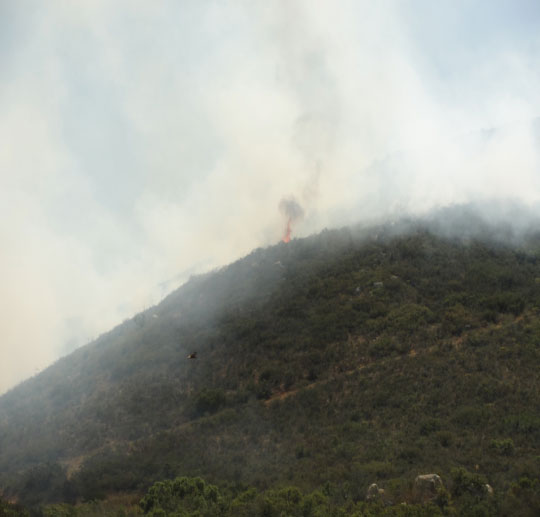 |
| Towering inferno. Flames reach an estimated 50 feet high in this photo taken at 2:16 on August 29. (Photo: Erik Cordova and Scott Ritchie, San Diego Mining Company) |
Once we reached the lemon grove at the end of Magee it was a surreal scene; there were two San Diego County Sheriffs and three fire vehicles sitting in the road with the lemon ranch caretaker Chris B. We stopped and talked about the situation. Chris stated he was worried the ranch might be affected and agreed it would be a good idea to open our mine gates. We cleared this with the fire crew and were on our way through the winding road of the lemon grove to where it meets the mine road. At this point none of the fire crew had utilized the mine road.
We made it to our first gate and the smoke could be seen along with two airtankers making fire retardant runs on the fire. We proceeded to the second mine gate and opened it. We had to also make sure the excavator had enough room to avoid any major fire damage, and since the fire was yet to reach the north side of Tourmaline Queen Mountain we decided to drive as close to the mine as possible. Once we reached an overlook of the mine, less than a mile away, it was clear the Tourmaline Queen Mine would be the first in the path of the burn. We stopped to take a few pictures and moved on. We reached the Tourmaline Queen property and were about 200 feet or less away from the major flames and thick smoke. The smoke was still sweet smelling because it was all natural brush burning; without the plastic, treated wood and other synthetic materials to burn, the fire almost smelt good. But at that point pleasant smells were the last thing on our minds.
There were several bulldozers headed up from the Stewart Mine to cut fire breaks and allow a corridor for the fire crews on foot. We could hear them through the flames and thick smoke. They couldn’t have been more than 250 feet away but there was no way to see them. At this point we heard a plane headed our way. Scott and I looked at each other knowing well what was about to happen. We made a quick dash for the Land Cruiser—the fire retardant was about to drop! We made it to the truck and closed the doors just as the retardant made its orange coating on the Toyota with only a nanosecond to spare.
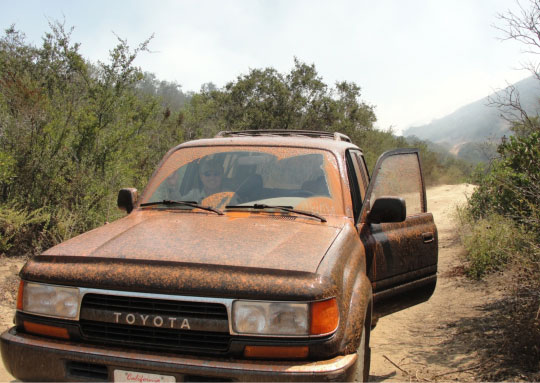 |
| Orange you lucky? Fire retardant gives the Land Cruiser a mottled makeover. Cordova and Ritchie had just enough time to take refuge in the vehicle before the airtanker dropped its load. (Photo: Erik Cordova and Scott Ritchie, San Diego Mining Company) |
After this we drove out of the area; we were pretty shaken up by then. Along the way out, there was a fire truck headed down the mine road. We explained the gates were open and that our road would be a very advantageous location to fight this monster. The fire crew seemed pleased they had the local support on this one.
The following day after the fire was well under control we headed back up to make sure the mine had survived. Making our way to the mine site there were many more fire trucks and huge four-wheel drive fire rigs along our route. In total 40 to 50 separate trucks had made the trip along the mine road and it was noted to us the mine road was instrumental in the fight to save the nearby residential community of Rancho Heights. This gave Scott and me some pride in our work. It didn’t just serve us but also helped save the local residents from losing valuable homes—or worse, a human life.
After getting the okay from the fire crew we made our way to the mine. Along the way we passed about 15 or 20 trucks positioned along the mine roadway in strategic spots to monitor in case of new flare-ups. At the mine site there were another 40 fire trucks and big fire rigs that had made a base camp at the northern boundary of the Tourmaline Queen Mine. We introduced ourselves and expressed our thanks and appreciation for the firefighting efforts to as many of the crew as possible. Without the efforts of these fine men and women there would be nothing left of the brush or the many million-dollar homes in the Rancho Heights area—also Magee Road residents would have been in the path of destruction. This was the best and most well organized firefighting effort I had ever seen.
After inspecting the Tourmaline Queen and King Mines we noted that about 90% of the Queen mine vegetation had been burned and almost none of the King mine property had been affected. One thing we were worried about was the bulldozers making their way to the upper workings of the Tourmaline King. There is an old roadway that was causing drainage problems that we had just completed reclamation on, and if the dozers would have touched it, it would have caused more work for us. Fortunately the dozers didn’t need to go that far around the northwest section of Tourmaline Queen Mountain, so our work was unaffected.
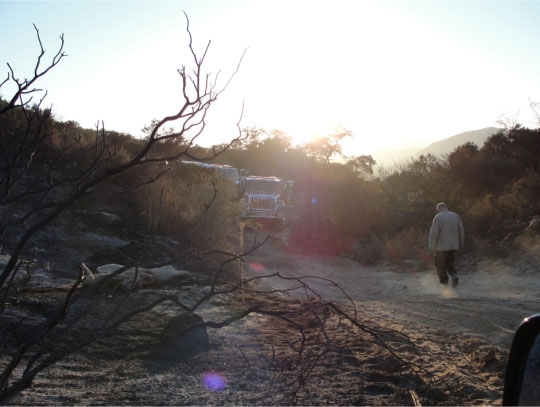 |
| Vivat Rex Tourmalinis. On the evening of August 30, Scott Ritchie walks up to firefighters to ask for clear passage to the Tourmaline King Mine in order to check on its workings and equipment. Fortunately, the King had been spared. (Photo: Erik Cordova and Scott Ritchie, San Diego Mining Company) |
There were about 20 inmate fire crew workers taking a well deserved rest at the Tourmaline Queen Mine. We stopped to talk with them and the fire captains about the mines and local history of the area. It was a nice conversation and I think they enjoyed the break from focusing on the fire. After a good viewing of the mine properties we knew it would be best to leave the professionals to their monitoring work. There were about 20 trucks and 30 or 40 firefighters that camped out for the night to keep the flare-ups and smoldering spots from starting to burn again.
Once again we want to thank all the fire crews for their valiant efforts and swift actions that stopped this potential life threatening fire from spreading to that point.
Thank you to Erik Cordova and Scott Ritchie for a very engaging story.
[back to top]
August 2011 Newsletter
In this edition of Pala Mineralis we feature a yummy sundae of a specimen from Namibia’s Erongo Mountains, and from Germany’s Eifel Mountains some bon motes measured in mms (and ahhs)—the fourth in our FotogFocus series. Pala signs on the line for a mine just in time to do some dealing in Denver. Bill Larson is fêted in France and a mining museum endures the exit of an exhibit.
Shows and Exhibitions
- Pala at Colorado Mineral & Fossil Show September 14–18, 2011
- Sterling Hill Mining Museum’s Gold Specimen Collection Stolen
- BlueCap Looks Back at Tucson, Looks Forward to Dallas
Pala International News
- Pala’s Featured Mineral Specimen
- Bill Larson Receives Diplome d’Honneur at Sainte-Marie-aux-Mines Fête
- Esmeralda Mine to Shine Again
Special Feature
Shows and Exhibitions
Pala at Colorado Mineral & Fossil Show
September 14–18, 2011
Pala International will be at the Colorado Mineral & Fossil Show.
- When: Sept. 14–18, 2011
- Where: Holiday Inn Denver–Central, 4849 Bannock St.
- Room 183
- Hours:
Wed.–Sat.: 10 a.m.– 6 p.m.
Sun.: 10 a.m.– 5 p.m.
We look forward to seeing our many friends there. For more information visit the show website.
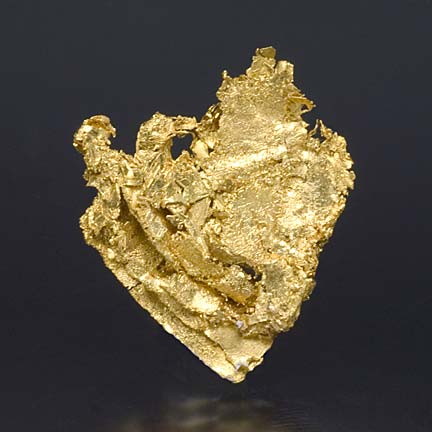 |
| Gold leaf from Breckenridge, Colorado, 3.1 x 2.6 x .4 cm. It has two old labels: one from the Collection of T. M. Phetteplace and the other from Lidstrom’s. It’s available. (Photo: John McLean) |
Visit the Pala International Show Schedule for future events. [back to top]
And speaking of gold from Breckenridge…
Sterling Hill Mining Museum’s Gold Specimen Collection Stolen
In the early afternoon of July 27, between 15 and 20 specimens from a New Jersey mining museum were stolen. The unidentified suspect smashed a Plexiglass enclosure in the main exhibit hall of Sterling Hill Mining Museum, in Ogdensburg, according to a very detailed story in the New Jersey Herald. The exhibit was displayed in a case installed in a vintage 6-foot tall safe made by the Marvin Safe Company.
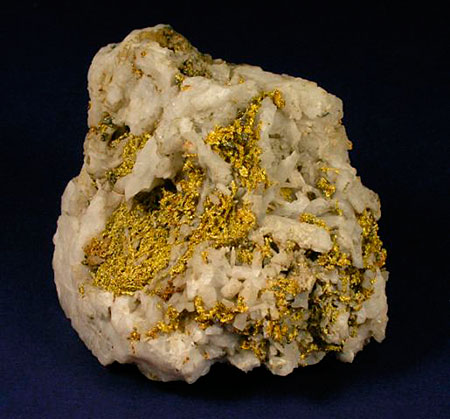 |
| Gold gone. This specimen, also from Breckenridge, Colorado, is but one of 13 photos of the gold specimens stolen from the Sterling Hill Mining Museum. It measures 8 x 8 x 6 cm. (Photo courtesy Sterling Hill Mining Museum) |
The Herald story stated that museum co-owner Richard Hauck and his wife collected the specimens, which were on loan to the museum, over a 40-year period. A $25,000 reward is offered for the collection, which is valued at more than $400,000. Specimens of this sort, of course, are worth far more than their “weight in gold”; Hauck estimated that its value would decrease by as much as 80 percent if the specimens were altered or melted.
While the Herald quoted Hauck as saying the suspect left behind a telltale trail, when we called the museum today, no arrest had been made. Gratitude was expressed by the museum for spreading the word about the theft. Anyone with information to offer is asked to call either Richard or Robert Hauck at 973.209.7212 or send an email to Earl Verbeek. [back to top]
BlueCap Looks Back at Tucson, Looks Forward to Dallas
What’s Hot In Tucson 2011 – Minerals
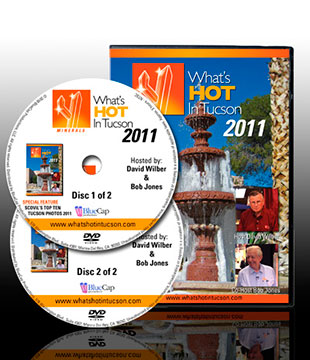 |
The fifth annual edition of What’s Hot in Tucson was released in mid-July by BlueCap Productions. The crew spent three weeks at five shows, with hosts David Wilber and Bob Jones. Over 500 hours of show time are simmered to a tasty reduction of 4 hours on two DVDs.
From the BlueCap writeup: “Along the way we see some of the ilvites from China that made such a huge hit, the Russian cuprites that were one of the hottest new finds at Tucson, one of the finest emerald specimens in the world, a behind-the-scenes viewing of the new kunzites from Pala, an exclusive interview with the owner of the Tourmaline Queen Mine and the first owner of the world-famous Rabbit Ears blue cap (Dave Wilber was the second owner), and a whole lot more!”
The DVD set also features photographer Jeff Scovil’s Top Ten Tucson Photos.
Friends of Pala International get a 10% discount on any BlueCap order. Just enter the code palaintl when you’re asked for it while ordering.
What’s Hot In Dallas
Last summer, mineral purveyor Rob Lavinsky held an event to mark the opening of his new Arkenstone gallery in Dallas. That informal event has developed into an annual meeting, the Dallas Mineral Collecting Symposium, co-hosted by the Mineralogical Association of Dallas and Southern Methodist University’s Department of Geology. The event is scheduled for Saturday, August 27. Topics and speakers:
- Museum Activities: Collections, Curation, and Philanthropy
- Dr. Jeffrey Post of the Smithsonian’s Museum of Natural History, Dr. Joel Bartsch of Houston Museum of Natural Science, and
Marc Wilson of Carnegie Museum of Natural History
- Dr. Jeffrey Post of the Smithsonian’s Museum of Natural History, Dr. Joel Bartsch of Houston Museum of Natural Science, and
- Tax Implications of Philanthropy and Donations to Museums
- Hon. Francis Allegra, Federal Judge and legal columnist for The Mineralogical Record
- The Science Behind Collectable Gem Crystals
- Dr. Barbara Dutrow, Louisiana State University and
Dr. George Rossman, Caltech
- Dr. Barbara Dutrow, Louisiana State University and
BlueCap Productions will be there this year, and offers the DVD Dallas Mineral Symposium: 2010. Presentations were by collector and author Gene Meieran (Senior Intel Fellow) and Apollo 17 astronaut Harrison Schmidt (first geologist to walk on the moon). [back to top]
Pala International News
Pala’s Featured Specimen: Aquamarine from Namibia
This month we feature a complex and stunning aquamarine specimen from the Erongo Mountains in Namibia. This wonderful find was first discovered about two year ago. Many specimens are comprised of this outstanding mix of blue aqua, black schorl and white feldspar. This dramatic combination is very appealing and diagnostic of the Erongo region. When you see a fantastic specimen like this one, you will know exactly where it’s from.
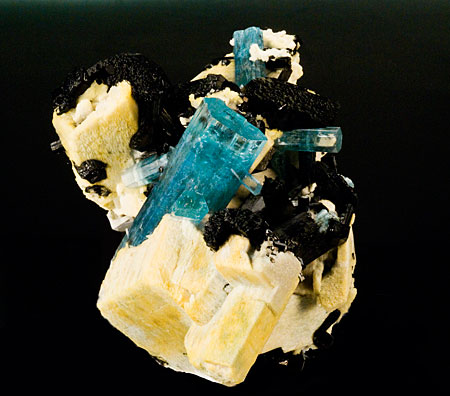 |
| Aquamarine, schorl and feldspar from Namibia, 14 x 11 x 8 cm. Price available upon request. Click to enlarge. (Photo: Mia Dixon) |
Some time ago, Pala bought a large parcel of these black, white and blue specimens from thumbnails to cabinet size. Now it seems we have saved the best for last with this particular monster. Pala recently obtained this piece, which was held back for a while in a private collection in Idar-Oberstein.
See our selection of aquamarine here. Many other pieces that have not been posted are available.
Bill Larson Receives Diplome d’Honneur
at Sainte-Marie-aux-Mines Fête
Surprise party celebrates years of support
As this year’s Sainte-Marie show was closing, at 7 p.m. on Friday, a general announcement was heard over the loudspeakers inviting everyone to visit the hospitality booth. “So we went,” Bill Larson told us, “with a couple hundred people for food and drink. And it turned out to be just about me??!”
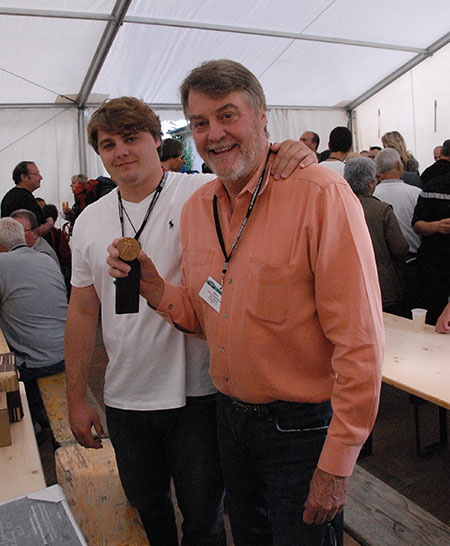 |
| Medallist. Bill Larson, with son Carl, shows off the medal of the village of Sainte-Marie-aux-Mines. (Photos: Will Larson and Mia Dixon) |
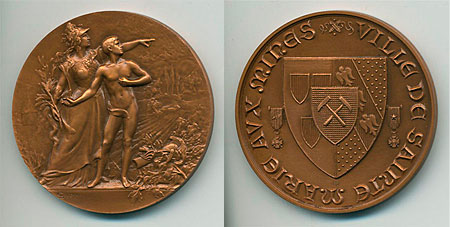 |
“I was given a unique honor as ‘un Américain’ who tirelessly promotes their show and town,” Bill said, “compete with speeches, ‘oom-pah-pah’ band and ceremony.” Ste-Marie show organizer Michel Schwab presented Bill with a diploma of appreciation, and mayor Claude Abel gave him the village medal. “It was awesome!” said Bill. “The French are special.”
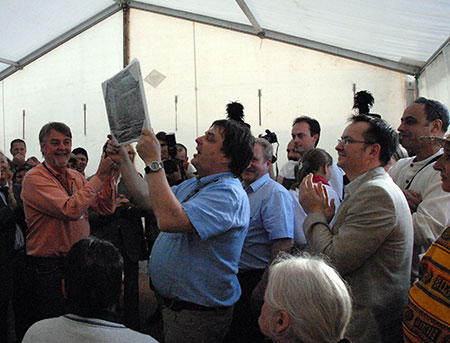 |
| Diplomate. Above, Bill Larson is presented a diploma of appreciation by show organizer Michel Schwab. Below, he receives the village medal from mayor Claude Abel. (Photos: Will Larson) |
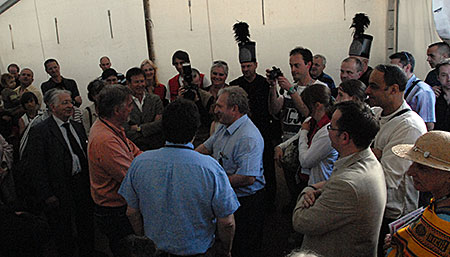 |
Son Will Larson and French dealer Alain Martaud were in on the act months before, in case Bill might take the opportunity to run off by himself. To insure no slip of the tongue, Will’s brother Carl and their colleague Mark Kaufman, weren’t told about the event until just days before. So utterly surprised was Bill, we’re told he turned a rhodochrosite red.
 |
| The diploma reads, “in thanks for his unconditional and faithful support,” and includes a specimen of opal, for which the show held a special exposition, Les Routes de L‘Opale. (Photo: Will Larson) |
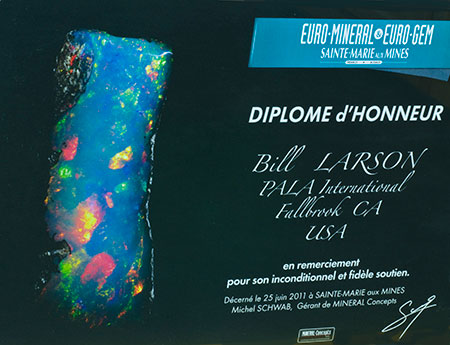 |
[back to top]
Esmeralda Mine to Shine Again
Pala’s possession just signatures away…
For the past ten years, Pala International has engaged in a quest to obtain the Esmeralda Mine in Mesa Grande, California. The purchase is nearly complete, having entered escrow on July 12 and now funded. All that remains are the final signatures. Pala plans to begin extension of work on the mine, which has lain dormant for decades.
Esmeralda is the Spanish and Portuguese word for emerald. The mine may have been named for the “rich emerald green” tourmaline noted by George F. Kunz in his description below.
G. F. Kunz on the Esmeralda Mine, ca. 1904
The following was published as an entry (pp. 136–137) in Gems, Jewelers’ Materials, and Ornamental Stones of California, Bulletin No. 37, issued June 1905 by the California State Mining Bureau. It was compiled by George F. Kunz, A.M., Ph.D.
The Esmeralda mine, owned by J. D. Stone and H. E. Dougherty, both of Mesa Grande, Cal., is situated about 5 miles northwest of the Mesa Grande store, and 1¼ miles west of the Himalaya mine, and on the eastern slope of the Temescal Valley, in the S. E. ¼ of the S. E. ¼ [sic] of Sec. 13, T. 11 S., R. 1 E., S. B. M. The mine was discovered May 7, 1904, by Mr. Dougherty, and was acquired by location as a quartz ledge. The altitude is 3470 feet.
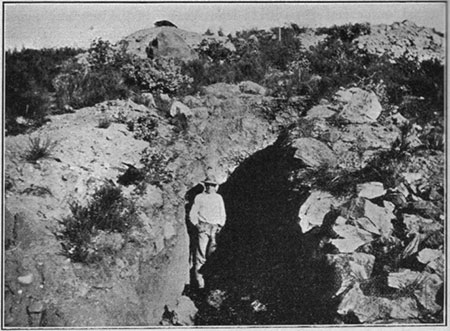 |
| Esmeralda Mine, Mesa Grande—tunnel looking east. Included in the entry compiled by George F. Kunz. From the collection of Bill Larson. |
The course of the ledge is northeast and southwest; but where the work is being done a spur running southwest and northeast at right angles with the main ledge has produced all the gems yet found. The ledge dips to the southwest at an angle of 26 degrees an is about 10 feet in width at the point opened. The claim embraces one large ledge and numerous stringers, showing gem indications. The work at present performed consists of two open cuts crossing the vein and exposing it to a depth of 7½ feet; a tunnel 60 feet below the surface workings tapped the ledge at 28 feet; but no further work has been done in the tunnel, and no gems were found in the formation at that place.
Both hanging and foot walls are composed of a coarse, crystallized hornblendic diorite of a rich grass-green color, resembling a serpentine. The ledge itself is pegmatite, and is faulted in several places by volcanic action. The pegmatite is of the coarse granitic type met with in nearly all the gem mines in the southern belt. The pockets are quite large, and contain quartz crystals, orthoclase, and albite in beautiful transparent crystallizations. Lepidolite in pieces weighing from 50 to 300 pounds also occurs in conjunction with the pocket material. Tourmaline is the only perfect gem found, and occurs in pink bright red, azure blue, aquamarine blue, and a peculiar shade of green blue, and another set a rich emerald green. Crystals of this character have not been noticed in any other tourmaline mine in southern California, although fine blues and greens exist in other places. With the lepidolite is a granular blue and lavender mineral which could not be determined, but apparently is a lithia compound.
In examining the ledge, 2½ feet of pegmatite were found overlying the pocket stratum. The pockets themselves were filled with soil and foreign matter, rendering it impossible to say exactly what the nature of the softer material that once filled them had been. Some pockets were hollow, containing nothing but quartz crystals, while near them were pockets absolutely filled with tourmaline pencils. The lower strata or line-rock of these ledges is also pegmatitic, although of much finer crystallization than the top. About 250 feet southwest of the tourmaline workings, the ledge is badly broken and shows only in places, in the nature of blowouts of pegmatite and quartz. In some of these blowouts golden and aquamarine beryl were found frozen in the formation. Many of these pieces were of excellent gem quality, and the owners signify their intention of doing considerable development work at these places. About $300 has been expended, producing about 20 pounds of tourmaline of gem quality. As in many other cases of prospecting and mining for gems in southern California, lack of funds has greatly hindered the proper development and exploiting of this mine.
There is neither timber nor water on the mine, but an abundance of timber can be secured within half a mile. Also, water can be piped to the property from springs on the hill above.
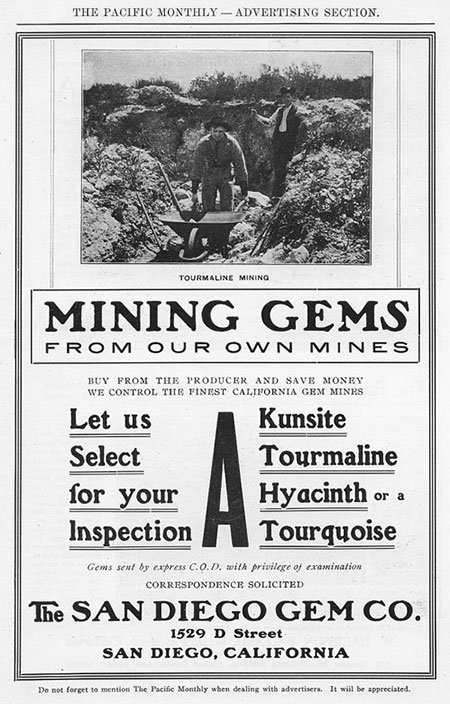 |
| Doc Wilson, with wheelbarrow, above, at the Esmeralda Mine, and below, identified in the March 1906 Pacific Monthly as “an eminent mineralogical gem authority,” and president of the San Diego Gem Company. From the collection of Bill Larson. |
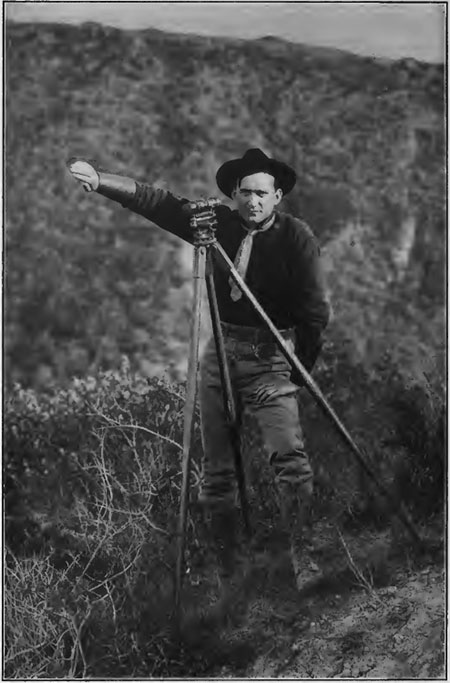 |
And 50 years later…
We have abstracted the following, which originally was summarized from personal communication, in 1957, furnished by Caltech’s R. H. Johns, and which appeared in Mines and Mineral Resources of San Diego County, California, County Report 3, by F. Harold Weber Jr., issued by the California Division of Mines and Geology, 1963, pp. 89–91.
Ownership: Peter Martin, 16th Street, San Diego 16, owns one claim that was patented in 1908, and recently located additional claims that border the patented claim (1960).
The deposit was prospected from 1899 to 1904, and claims first located on it by Gail Lewis and subsequently by Arthur L. Watkins. The first serious development was undertaken in 1904 by Harry Dougherty, who organized and operated the Native Gem Mining Company. The mine was worked intermittently from 1904 until about 1909. The property has had several owners since that time and was purchased by Mr. Martin in mid-1957.
The pegmatitic dikes in the mine area occur in medium- to coarse-grained gabbroic rocks. The main dike, which is broadly sinuous, ranges in thickness from 2 feet to nearly 40 feet in the mine area, and is locally very irregular in detail. It trends north-northwest and dips steeply west-northwest in the vicinity of the southern group of workings where it splits into several subparallel branches.
The principal rock type in all of the dikes is graphic granite which contains scattered, but locally abundant, albite, muscovite, and quartz. In most places it forms almost the entire thickness of the dikes. Only in the thickest parts of the main dike are other types of pegmatite prominent. The core of this dike is exposed only in the underground workings beneath the main cuts.
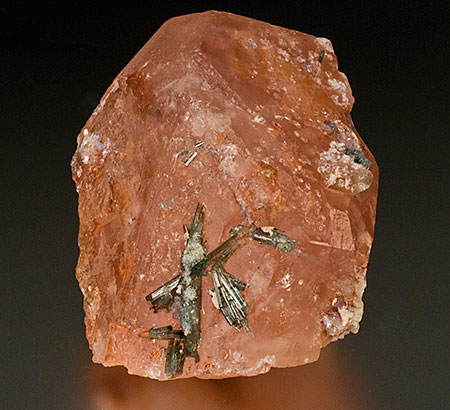 |
| Morganite with tourmaline, from the Esmeralda Mine, 9.5 x 6 cm. Formerly in the T. W. Warner Jr. Collection. (Specimen: Bill Larson Collection; Photo: Mia Dixon) |
Gem-quality beryl, tourmaline, and quartz, the principal minerals mined, were taken mostly from one very large pocket that was encountered in the main workings. Quartz was particularly abundant and the output included one 148-pound crystal and several 40-pound crystals. Some of the quartz crystals were studded with partly intergrown tablets and thick prisms of beryl that ranged in color from white to salmon pink to rose pink. Many of these were as much as 1½ inches in diameter. The principal pocket also contained many prisms of gem-worthy tourmaline, some pink and some an unusual and beautiful blue-green. Several of these crystals are recorded to have been at least six inches long and one-half to one inch in diameter. The core also contains lepidolite muscovite, light-brown to reddish-brown zinnwaldite (rare), and cookeite.
And coming next time…
In our next edition of Pala Mineralis we will feature “Esmeralda Notes (Weekend 22–23 Sept 1956),” an unpublished manuscript by John Sinkankas. [back to top]
Special Feature
FotogFocus: Fred Kruijen – Small Wonders
A look at the artist behind the camera
In our last edition of Pala Mineralis, we pointed to the “diminutive delights” of photographer Fred Kruijen. He kindly accepted our offer to feature him as the fourth in our occasional series of mineral and gemstone photographers, FotogFocus.
Kruijen came to his small subjects’ site—the Eifel region of western Germany—through the pastime of fly-fishing in the placid waterways of the area. It’s during these visits that he found his first fossils and some “poor handpieces.”
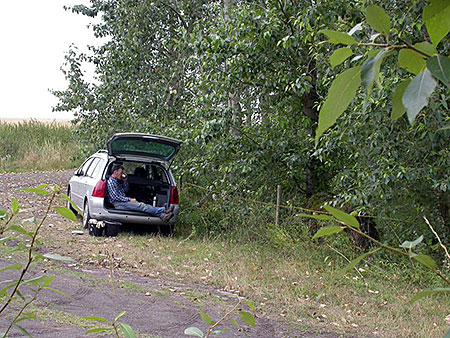 |
| Fred Kruijen takes a break from specimen-hunting, fly-fishing, or both. (Photo: Fred Kruijen) |
His interest in minerals, thus kindled, found full flame when a chance encounter with a stereo-microscope took him into “a new (tiny) world.” Read more in FotogFocus.
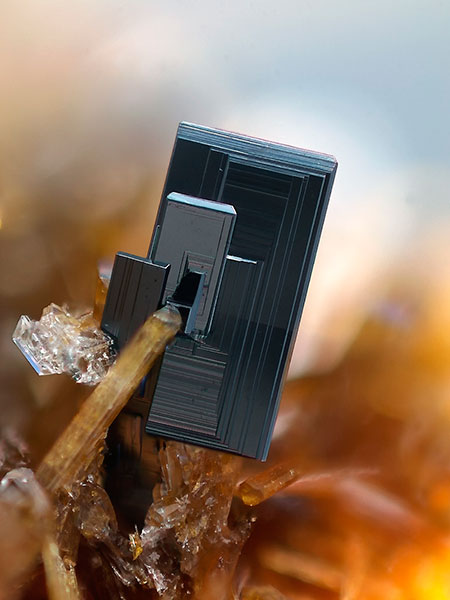 |
| Pseudobrookite from Bellerberg, in Germany’s Vulkan Eifel. (Photo: Fred Kruijen) |
[back to top]
— End August Newsletter • Published 8/2/11 —
